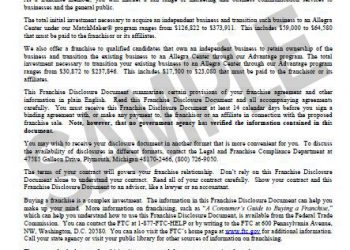After you’ve expressed serious intent on purchasing a franchise and at least two weeks before you sign a Franchise Agreement, the franchisor will provide you with a Franchise Disclosure Document.
Mandated by the Federal Trade Commission, the FDD is drawn up by franchise lawyers. It can run to hundreds of pages — a good portion of it in hard-to-understand legal language and difficult-to-interpret financial figures.
Your own attorney and accountant can help guide you through all 23 items the document addresses, but here are the primary items you’ll want to be on the lookout for:
- Item 2: Executive experience: Look for a franchisor executive team that instills confidence. They should have a solid background in franchising and management. Look out for executives who are new to franchising, or ones that have a history of failures in other businesses.
- Item 3: Litigation: Look for any litigation involving the franchisor. But know that not all lawsuits are bad. For example, a franchisor that has filed a suit against a franchisee who’s not in compliance with brand standards is one that’s protective of its corporate identity. Look out for lawsuits filed by franchisees that allege fraud or misrepresentation on the part of the franchisor. That’s a red flag for potential future trouble.
- Item 7: Initial expenses: Look for an accurate accounting of the fees and expenses that are required to open and operate a franchise for the first three months. Look out for an overly optimistic tally. Remember that many franchisees encounter difficulties when they’re undercapitalized. Review this section carefully with your accountant. Also, seek out the input of other franchisees to see how long it took them to break even.
- Item 9: Franchisee’s obligations: Look for a comprehensive list of your obligations along with cross-references to the Franchise Agreement and the rest of the FDD. This is your opportunity to learn what you’re getting into. Look out for Franchise Disclosure Document descriptions that are inconsistent with the Franchise Agreement. This is another red flag.
- Item 19: Financial performance: Look for financial information on how much franchisees are earning. But beware that only 30 to 40 percent of franchisors disclose these figures. Others must state that they decline to make such a claim. Look out for earnings based on franchises that have been open for five to 10 years. These figures may be somewhat misleading in that established locations may pay lower rents. Also, know that the earnings claims for corporate stores (if any) will not be reflective of franchise operations. They pay no royalties.
- Item 20: Franchise information: Look for the number of franchises opened, transferred and closed during in the past three years. This will show you if the network is shrinking, holding its own or expanding. Also, see the list of current and former franchisees. Contact as many as you can to gain an independent perspective on the health of the system. Look out for a large or growing number of franchise closures. This could mean the business model is no longer in favor.
- Item 21: Financial statements: Look for evidence that the franchisor is financially stable. The profit-and-loss statement and balance sheet are key. Rely on your accountant to help determine if the franchisor’s ratio of assets to liabilities is favorable, and how they account for deferred revenue. Look out for franchisors who derive most of their income from franchise sales. The best systems sustain themselves on franchise royalty payments.









